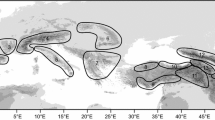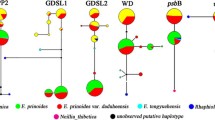Abstract
Viola jaubertiana Marès & Vigin. is a narrow endemic violet of the Balearic Islands, restricted to small, fragmented, and scattered populations living in inaccessible rocky places and calcareous overhangs. V. jaubertiana is entirely glabrous and morphologically very uniform. However, several authors have reported hairy individuals collected at the type locality, suggesting that these rupicolous, pubescent plants are putative hybrids with V. alba Bess. subsp. dehnhardtii (Ten.) W. Becker, a woodland violet growing in the area. Ribosomal ITS sequences of the putative hybrids analysed showed additive species-specific sites of V. alba subsp. dehnhardtii and V. jaubertiana, strongly supporting its hybrid origin from these progenitors. CpDNA sequences of all putative hybrids were uniform, and identical to those present in V. jaubertiana accessions. This suggests that the gene flow between V. alba subsp. dehnhardtii and V. jaubertiana is unidirectional and identifies the endemic V. jaubertiana as the unique ovule donor. The additivity of the ITS sequences, together with the pollen and ovule sterility, suggests that the sampled individuals are primary F1 hybrids, whereas no trace of introgressive hybridization or hybrid zone has been evidenced by the nuclear and plastid markers used. Judging from herbarium sheets, hybridization between V. alba subsp. dehnhardtii and V. jaubertiana is recurrent and dates back from the XIXth century. Hybrids between these species are not linked to disturbed environments. In fact, they have been always reported in rupicolous habitats, where the maternal species is restricted.

Similar content being viewed by others
References
Abbot R (1992) Plant invasions, interspecific hybridization and the evolution of new plant taxa. Trends Ecol Evol 7:401–405
Álvarez I., Wendel JF (2003) Ribosomal ITS sequences and plant phylogenetic inference. Molec Phylogenet Evol 29:417–434
Arnheim N (1983) Concerted evolution of multigene families. In: Nei M, Koehn R (eds) Evolution of genes and proteins. Sinauer, Sunderland, pp 38–61
Arnold ML (1997) Natural hybridization and evolution. Oxford University Press, Oxford
Arnold ML (2006) Evolution through genetic exchange. Oxford University Press, Oxford
Avise JC (1994) Molecular markers, natural history and evolution. Chapman & Hall, New York
Ballard HE Jr, Sytsma KJ, Kowal RR (1999) Shrinking the violets: phylogenetic relationships of infrageneric groups in Viola (Violaceae) based on internal transcribed spacer DNA sequences. Syst Bot 23:439–458
Beattie AJ, Lyons N (1975) Seed dispersal in Viola (Violaceae): adaptations and strategies. Amer J Bot 62:714–722
Brochmann C (1984) Hybridization and distribution of Argyranthemum coronopifolium (Asteraceae-Anthemidae) in the Canary Islands. Nord J Bot 4:729–736
Buckler ESI, Ippolito A, Holtsford TP (1997) The evolution of ribosomal DNA: divergent paralogous and phylogenetic implications. Genetics 145:821–832
Buerkle CA, Wolf DE, Rieseberg LH (2003) The origin and extinction of species through hybridization. In: Brigham CA, Schwartz MW (eds) Population viability in plants. Springer, Berlin, pp 117–141
Burnat E, Barbey W (1882) Notes sur un voyage botanique dans les îles Baléares et dans la province de Valence (Espagne). Mai–Juin, 1881. H. George, Genève and Bâle
Chodat L (1924) Contributions à la Géo-Botanique de Majorque. Bull Soc Bot Genève ser.2, 15:153–264
Contandriopoulos J, Cardona MA (1984) Caractère original de la flore endémique des Baléares. Bot Helvet 94:101–131
Crockett SL, Douglas AW, Scheffler BE, Khan IA (2004) Genetic profiling of Hypericum L. (St. John’s Wort) species by nuclear ribosomal ITS sequence analysis. Planta Med 70:929–935
Culley TM (2002) Reproductive biology and selfing rates in Viola pubescens (Violaceae), and understory herb with chasmogamous and cleistogamous flowers. Int J Pl Sci 163:113–122
Davis PH (1951) Cliff vegetation in the Eastern Mediterranean. J Ecol 39:63–93
Dover G (1994) Concerted evolution, molecular drive and natural selection. Curr Biol 4:1165–1166
Doyle J, Doyle JJ (1987) A rapid DNA isolation procedure for small quantities of fresh leaf tissue. Phytochem Bull 19:11–15
Erben M (1996) The significance of hybridization on the forming species in the genus Viola. Bocconea 5:113–118
Fuertes-Aguilar J, Rosselló JA, Nieto-Feliner G (1999) Nuclear ribosomal DNA (nrDNA) concerted evolution in natural and artificial hybrids of Armeria (Plumbaginaceae). Molec Ecol 8:1341–1346
Galbany-Casals M, García-Jacas N, Susana A, Sáez L, Benedí C (2004) Phylogenetic relationships in the Mediterranean Helichrysum (Asteraceae, Gnaphalieae) based on nuclear rDNA ITS sequence data. Austral Syst Bot 17:241–253
Grant V (1981) Plant speciation. Columbia University Press, New York
Harris SA, Ingram R (1991) Chloroplast DNA and biosystematics: the effects of intraspecific diversity and plastid transmission. Taxon 40:393–412
Kimura M (1980) A simple method for estimating evolutionary rate of base substitutions through comparative studies of nucleotide sequences. J Molec Evol 16:111–120
Krahulcova A, Krahulec F, Kirschner J (1996) Introgressive hybridization between a native and an introduced species: Viola lutea subsp. sudetica versus V. tricolor. Folia Geobot 31:219–244
Lai Z, Gross B, Zou Y, Andrews J, Rieseberg LH (2006) Detecting differential gene expression in homoploid hybrid sunflower species using microarrays. Molec Ecol 15:1213–1227
Levin DA (2000) The origin, expansion, and demise of plant species. Oxford University Press, Oxford
Levin DA, Francisco-Ortega JF, Jansen RK (1996) Hybridization and the extinction of rare plant species. Conserv Biol 15:10–16
Malécot V, Marcussen T, Munzinger J, Yockteng R, Henry M (2007) On the origin of the sweet-smelling Parma violet cultivars (Violaceae): wide intraspecific hybridization, sterility, and sexual reproduction. Amer J Bot 94:29–41
Marcussen T, Borgen L (2000) Allozymic variation and relationships within Viola subsection Viola (Violaceae). Pl Syst Evol 223:29–57
Marcussen T, Nordal I (1998) Viola suavis, a new species in the Nordic flora, with analyses of the relation to other species in subsection Viola (Violaceae). Nordic J Bot 18:221–237
Marcussen T, Borgen L, Nordal I (2001) Viola hirta and its relatives in Norway. Nordic J Bot 21:5–17
Marès P, Vigineix G (1880) Catalogue raisonné des plantes vasculaires des Iles Baléares. G. Masson, Paris
Mus M, Sáez L, Rosselló JA (2000) Viola barceloi Nyman, V. barceloi L. Chodat and V. suavis var. barceloi O. Bolos & Vigo: too many eponyms or too many taxa? Taxon 49:785–788
Nasrallah ME, Yogeeswaran K, Snyder S, Nasrallah JB (2000) Arabidopsis species hybrids in the study of species differences and evolution of amphiploidy in plants. Pl Physiol 124:1605–1614
Neuffer B, Auge H, Mesch H, Amarell U, Brandl R (1999) Spread of violets in polluted pine forests: morphological and molecular evidence for the ecological importance of interspecific hybridization. Molec Ecol 8:365–377
Nieto-Feliner G, Gutiérrez-Larena B, Fuertes-Aguilar J (2004) Fine scale geographical structure, intra-individual polymorphism and recombination in nuclear ribosomal internal transcribed spacers in Armeria (Plumbaginaceae). Ann Bot 93:189–200
Oh BJ, Ko MK, Lee CH (1998) Identification of the series-specific random amplified polymorphic DNA markers of Viola species. Pl Breed 117:295–296
Rieseberg LH (1995) The role of hybridization in evolution: old wine in new skins. Amer J Bot 82:944–953
Ritland CE, Ritland RK, Straus NA (1993) Variation in the ribosomal internal transcribed spacers (ITS1 and ITS2) among eight taxa of the Mimulus guttatus species complex. Molec Biol Evol 10:1273–1288
Rosselló JA, Sáez L (2001) Index balearicum: an annotated check-list of the vascular plants described from the Balearic Islands. Collect Bot (Barcelona) 25:1–192
Rosselló JA, Mayol M, Mus M, Torres N (1991) Taxonomia i nomenclatura de plantes baleàriques. Boll Soc Hist Nat Balears 32:153–154
Rhymer JM, Simberloff D (1996) Extinction by hybridization and introgression. Annual Rev Ecol Syst 27:83–109
Saitou N, Nei M (1987) The neighbor-joining method: a new method for reconstructing phylogenetic trees. Molec Biol Evol 4:406–425
Schmidt A (1961) Zytotaxonomische Untersuchungen an europäischen Viola-Arten der Sektion Nomimium. Oester Bot Zeitschr 108:20–88
Simmons RE, Griffin M, Griffin RE, Marais E, Kolberg H (1998) Endemism in Namibia: patterns, processes and predictions. Biodiv Conserv 7:513–530
Siuta A, Bozek M, Jedrzejczyk M, Rostanski A, Kuta E (2005) Is the blue zinc violet (Viola guestphalica Nauenb.) a taxon of hybrid origin? Evidence from embryology. Acta Biol Crac Ser Bot 47:237–245
Soltis PS, Soltis DE (1991) Multiple origins of the allotetraploid Tragopogon mirus (Compositae): rDNA evidence. Syst Bot 16:407–413
Swofford DL (2002) PAUP*. Phylogenetic analysis using parsimony (*and other methods), 4th edn, Sinauer, Sunderland
Sytsma KJ, Smith JF (1992) Molecular systematics of Onagraceae: examples from Clarkia and Fuchsia. In: Soltis PS, Soltis DE, Doyle JJ (eds) Molecular systematics of plants. Chapman & Hall, New York, pp 295–323
Taberlet P, Gielly L, Patou G, Bouvet J (1991) Universal primers for amplification of three non-coding regions of chloroplast DNA. Pl Molec Biol 17:1105–1109
Tchourina O (1909) Note sur le Viola jaubertiana Marès. Bull Soc Bot Genève Ser. 2, 1:204–207
Ungerer MC, Baird SJE, Pan J, Rieseberg LH (1998) Rapid hybrid speciation in wild sunflowers. Proc Natl Acad Sci USA 95:11757–11762
Valentine DH (1949) The experimental taxonomy of two species of Viola. New Phytol 49:194–212
Valentine DH (1958) Cytotaxonomy of the rostrate violets. Proc Linn Soc Lond 169:132–134
Valentine DH (1975) Viola L. In: Stace CA (ed) Hybridization and the Flora of the British Isles. Academic Press, London, pp 154–163
Wendel JF, Schnabel A, Seelanan T (1995) Bidirectional interlocus concerted evolution following allopolyploid speciation in cotton (Gossypium). Proc Natl Acad Sci USA 92:280–284
White TJ, Bruns T, Lee S, Taylor J (1990) Amplification and direct sequencing of fungal ribosomal RNA genes for phylogenetics. In: Innis M, Gelfand D, Sninsky J, White T (eds) PCR protocols: a guide to methods and applications. Academic Press, San Diego, pp 315–322
Yockteng R, Ballard HE, Mansion G, Dajoz I, Nadot S (2003) Relationships among pansies (Viola section Melanium) investigated using ITS and ISSR markers. Pl Syst Evol 241:153–170
Yoo K-O, Jang S-K, Lee W-T (2005) Phylogeny of Korean Viola based on ITS sequences. Korean J Pl Taxonomy 35:7–23
Acknowledgments
We are indebted to our colleague Arántzazu Molins for her generous help throughout the field sampling and lab work. Relevant samples were provided by Pere Fraga and the staff of the Botanical Garden of Sóller (Balearic Islands). We thank Gonzalo Nieto-Feliner for friendly discussions, and the comments of two anonymous reviewers that improved the manuscript. This work has been partially funded by the CGL2007-60550/BOS project.
Author information
Authors and Affiliations
Corresponding author
Rights and permissions
About this article
Cite this article
Conesa, M.À., Mus, M. & Rosselló, J.A. Hybridization between insular endemic and widespread species of Viola in non-disturbed environments assessed by nuclear ribosomal and cpDNA sequences. Plant Syst Evol 273, 169–177 (2008). https://doi.org/10.1007/s00606-008-0006-2
Received:
Accepted:
Published:
Issue Date:
DOI: https://doi.org/10.1007/s00606-008-0006-2




